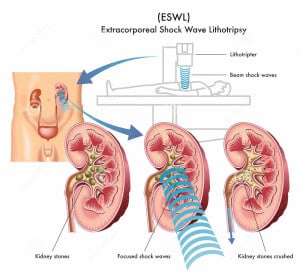 Lithotripsy is a general term for any procedure designed to break kidney stones, bladder stones, and ureteral stones. It involves breaking a stone into smaller particles via different means such as sound waves or laser energy. As a result, lithotripsy often helps patients effectively pass stone remnants through the urinary tract, or the fragments to be removed by the urologist in some instances .
Lithotripsy is a general term for any procedure designed to break kidney stones, bladder stones, and ureteral stones. It involves breaking a stone into smaller particles via different means such as sound waves or laser energy. As a result, lithotripsy often helps patients effectively pass stone remnants through the urinary tract, or the fragments to be removed by the urologist in some instances .
Comprehensive Urology in Los Angeles provides all modes of lithotripsy and other urological treatments. Our team includes highly trained urologists who work with patients, learn about their symptoms, and do everything they can to help patients address urinary stones.
Types of Lithotripsy
There are two types of lithotripsy: extracorporeal shock wave lithotripsy (ESWL) and ureteroscopic laser lithotripsy. Both treatments have been shown to help patients quickly, effectively, and safely eliminate urinary stones. However, your urological consultation with Comprehensive Urology will determine the ideal urinary stone treatment option.
How Does ESWL Work?
ESWL or “shockwave lithotripsy” involves the use of shock waves to break a urinary stone into small pieces that are easier to pass throughout the body. During an ESWL procedure, a patient first is brought to the surgical suite or operating room and lies down on a water-filled cushion. Next, a surgeon performs X-rays or ultrasound tests to determine the exact location of the stone. After the surgeon finds the stone, he or she administers a series of high-energy sound waves throughout a patient’s body. The sound waves disintegrate the stone into smaller pieces and do not harm a patient’s muscle or skin tissue.
ESWL is an outpatient procedure that requires only about one hour to complete under sedation or anesthesia. In most instances, patients can return home within a few hours of the procedure and pass their remaining urinary stone particles over the course of several days.
Are You a Candidate for ESWL?
Not all urinary stone patients are ideal candidates for ESWL. To qualify for ESWL, a patient must meet the following criteria:
- Has a urinary stone that blocks urine flow and is located in the renal pelvis or upper pole of the kidney (other locations have less success rates)
- Has a stone that ranges from 4 mm to 15 mm in diameter (ideally less than 10 mm)
- Has a stone that is not too hard (density of stone is measured on CT scan)
Comprehensive Urology is committed to helping patients find the right urinary stone treatment option. As such, we perform in-depth patient testing to determine if an individual is eligible to receive ESWL or other urinary stone treatments.
How Does Ureteroscopic Laser Lithotripsy Work?
A standard ureteroscopy involves the use of a long, thin fiber optic instrument (telescope) to locate and remove urinary stones. Once the stone is located, a surgeon then removes the stone with a small basket, or if too large, first perform laser lithotripsy to fragment the stone and then remove the pieces.
Comparatively, ureteroscopic laser lithotripsy is a variation of a traditional ureteroscopy. Whereas a standard ureteroscopy requires the use of a small basket (“scoop”) to remove a urinary stone, a ureteroscopic laser lithotripsy involves the use of a laser to break up a stone. At this point, a patient can pass any remaining stone particles through the urinary tract more effectively than ever before, and large pieces are removed by the basket.
Ureteroscopic laser lithotripsy is commonly used to address small or even some large urinary stones. It may be recommended for a patient based on the stone’s size, location, and other factors. It is a minimally invasive and very safe to perform.
Are You a Candidate for Ureteroscopic Laser Lithotripsy?
Ureteroscopic laser lithotripsy often proves to be a viable treatment for patients who are dealing with a ureteral stone or kidney stone(s). It also has been shown to provide an effective urinary stone treatment for pregnant women, obese patients, and individuals who are dealing with a blood clotting disorder or use blood thinners with very small risk for bleeding.
Comprehensive Urology’s expert team of urologists is happy to provide patients with full details about ureteroscopic laser lithotripsy and other urinary stone treatment options. By doing so, our team helps patients weigh the pros and cons of different procedures and make an informed treatment decision.
Choose Comprehensive Urology in Los Angeles for Non-Surgical Urinary Stone Treatments
Even a minor urinary stone can become a big problem, particularly for an individual who tries to ignore the issue. At the same time, surgery alternatives are available to help individuals treat urinary stones without going under the knife.
Comprehensive Urology in Los Angeles is proud to provide ESWL, ureteroscopic laser lithotripsy, and all other advanced urinary stone treatment options for all urinary stones despite the complexity. All of our urinary stone treatments are administered by expert surgeons who will do everything possible to help patients achieve their desired results. To find out more, please contact us today at (310) 499-2756 to schedule a consultation with one of our knowledgeable urologists.